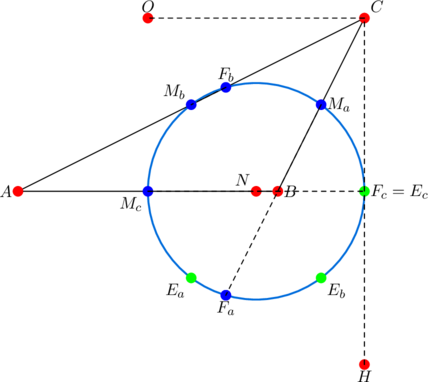Of the nine main points through which the nine-point circle passes, three of them are Euler points: the midpoints of the line segments joining the orthocenter to each vertex (for example, the three green dots ![]() in the diagram below).
in the diagram below).

(1) ![]()
only eight (rather than nine) points are present in the above nine-point circle, as the Euler point ![]() is forced to coincide with the foot of the altitude from vertex
is forced to coincide with the foot of the altitude from vertex ![]() . At the same time, the two Euler points
. At the same time, the two Euler points ![]() and
and ![]() correspond to the reflections of the midpoints of sides
correspond to the reflections of the midpoints of sides ![]() and
and ![]() over side
over side ![]() .
.
First suppose that ![]() and let
and let ![]() be the radius of the circumcircle of triangle
be the radius of the circumcircle of triangle ![]() .
.
By definition of the Euler points, ![]() is the midpoint of the segment joining vertex
is the midpoint of the segment joining vertex ![]() to the orthocenter
to the orthocenter ![]() . Since
. Since ![]() in any triangle, we have that
in any triangle, we have that ![]() . By the assumption we then have:
. By the assumption we then have:
![]()
By one of the equivalent statements here, we conclude that equation (1) holds. The converse is similar.
Just as in example 1 above.
Consider ![]() . Since
. Since ![]() from example 1 and
from example 1 and ![]() by definition, we have that
by definition, we have that ![]() is isosceles with base
is isosceles with base ![]() . The altitude through
. The altitude through ![]() bisects the base and so
bisects the base and so ![]() is a reflection of
is a reflection of ![]() over side
over side ![]() .
.
Consider ![]() and use example 2.
and use example 2.
Just as in example 1.
Takeaway
In triangle ![]() , let
, let ![]() denote the Euler points,
denote the Euler points, ![]() the foot of the altitude from vertex
the foot of the altitude from vertex ![]() , and
, and ![]() the midpoints of sides
the midpoints of sides ![]() . Then the following statements are equivalent:
. Then the following statements are equivalent:



 is the reflection of
is the reflection of  over side
over side 
 is the reflection of
is the reflection of  over side
over side 
- the side-lengths satisfy equation (1)
- the chord
 is a diameter of the nine-point circle
is a diameter of the nine-point circle
More in the task below.
Task
- (Early seventies) In a non-right triangle
 , let
, let  be the side-lengths,
be the side-lengths,  the altitudes,
the altitudes,  the feet of the altitudes from the respective vertices,
the feet of the altitudes from the respective vertices,  the midpoints of sides
the midpoints of sides  ,
,  the Euler points,
the Euler points,  the circumradius,
the circumradius,  the circumcenter,
the circumcenter,  the nine-point center,
the nine-point center,  the orthocenter,
the orthocenter,  the reflection of
the reflection of  over side
over side  ,
,  the reflection of
the reflection of  over side
over side  , and
, and  the reflection of
the reflection of  over side
over side  . PROVE that the following seventy-two statements are equivalent:
. PROVE that the following seventy-two statements are equivalent:







































 or
or 




 is the reflection of
is the reflection of  over side
over side 
 is the reflection of
is the reflection of  over side
over side 
 is congruent to
is congruent to 
 is congruent to
is congruent to 
 is isosceles with
is isosceles with 
 is isosceles with
is isosceles with 
 is right angled at
is right angled at 
 is the circumcenter of
is the circumcenter of 
 is right-angled at
is right-angled at 
 is right-angled at
is right-angled at 
- quadrilateral
 is a rectangle
is a rectangle - the points
 are concyclic with
are concyclic with  as diameter
as diameter - the reflection
 of
of  over
over  lies internally on
lies internally on 
- the reflection
 of
of  over
over  lies externally on
lies externally on 
- radius
 is parallel to side
is parallel to side 
 is the reflection of
is the reflection of  over side
over side 
- the nine-point center lies on

- the orthic triangle is isosceles with

- the geometric mean theorem holds
- the bisector of
 has length
has length  , where
, where 
- the orthocenter is a reflection of vertex
 over side
over side 
- segment
 is tangent to the circumcircle at point
is tangent to the circumcircle at point 
- median
 has the same length as the segment
has the same length as the segment 
- the bisector
 of
of  is tangent to the nine-point circle at
is tangent to the nine-point circle at 
 is a convex kite with diagonals
is a convex kite with diagonals  and
and 
- altitude
 is tangent to the nine-point circle at
is tangent to the nine-point circle at 
- chord
 is a diameter of the nine-point circle
is a diameter of the nine-point circle - segment
 is tangent to the nine-point circle at
is tangent to the nine-point circle at  .
.
( short of the target.)
short of the target.)
- (Extra feature) If
 satisfies equation (??), PROVE that its nine-point center
satisfies equation (??), PROVE that its nine-point center  divides
divides  in the ratio
in the ratio  .
.